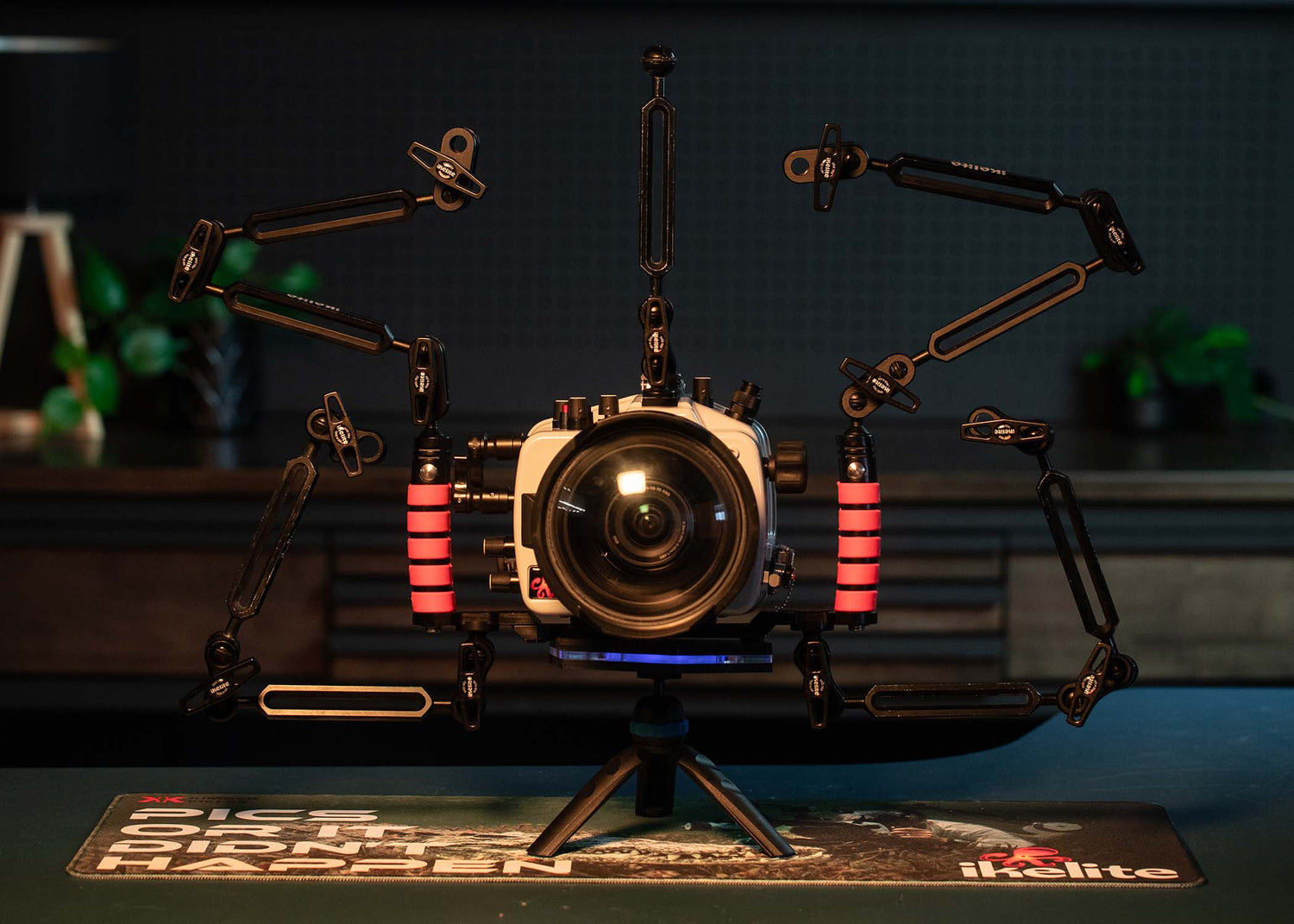By Bryant Turffs
Earlier this year, while listening to a technical talk by Dr. Alex Mustard, I heard the phrase “image quality vs. quality imagery.” I thought this was a brilliant way to summarize the difference between what our cameras do (create image quality in terms of sharpness, resolution, dynamic range etc.) vs. what our skills and vision do (create quality images in terms of subject selection, composition, treatment etc.). Many of us, myself included, chase the image quality provided by large high quality DSLR and mirrorless cameras. A large camera system, however, can come with trade offs.
Two important pieces of advice for creating quality images underwater are get close and get low. Getting close to your subject makes its importance in the image clear, prevents loss of color to light absorption, and preserves its detail. Getting low and shooting across or up at your subject creates a less common perspective (snorkelers look down!) and can create a personal connection to the subject through level eye contact. These strategies imbue the subject with interest and power.
I love shooting my Ikelite 200DL housing with dual DS160 Strobes and an 8” Dome Port, but I can only get it so close to the bottom or so far into a reef crevice, taking care to protect both the reef and camera. There are some practical limits to how close to some subjects and how low I can get.
Enter Ikelite’s brilliantly designed Base for DL housings (included with all 200DL and 50DL Underwater Housings). It allows for one or both handles to be removed with a 1/8" hex key, and has a variety of attachment points for Ball Mounts, requiring only a standard flathead screwdriver.

My housing with both handles attached, showing five optional ball mount locations. © Bryant Turffs
Having purchased a DSLR/Mirrorless camera rig with a dual handle tray, strobes, and strobe arms, most of us will always carry it in the basic configuration: with both handles attached. This has upsides. It is the most comfortable way to carry the system, allowing either hand or both to support its weight. It makes it easy to pass the camera between the surface and the boat. Downsides of this set up, however, are its width and that it is more convenient for landscape (horizontal) than portrait (vertical) orientation images.

The conventional dual handle tray and strobe set up. *Note that I have not attached a sync cable or fully assembled my housing for ease of demonstration. © Bryant Turffs

Southern Stingray • I like this image, but with my dual handle tray I could not place the camera lower down to try another angle. © Bryant Turffs

Porcupine fish • Shooting this image required me to finagle my strobes around from the conventional landscape set up to one better suited to a vertical image. Also, while not a problem in this instance, the left handle could have prevented me getting a lower angle. © Bryant Turffs
Non-Traditional DL Base Configuration
The first non-traditional configuration I like to use is one suited to portrait orientation. Vertical images are useful for magazine layouts and covers and are less common that landscape orientation images, probably due to the inconvenience of tilting our cameras sideways. As such, if I am planning a particular vertical image, like a benthic subject combined with a sun burst, or if I feel the need to gather vertical images, I remove one handle from my base and add an optional ball mount below the remaining handle. I prefer to remove the left handle, that leaves my trigger hand handle attached. This set up, combined with the Compact 8” Dome Port allows me to get my lens right down to the sand for a lower perspective and focuses me on vertical images.

My set up for portrait orientation images. © Bryant Turffs

Without the left handle, I was able to get my lens right down against the sand to capture this yellow stingray and the morning sun. © Bryant Turffs
Another configuration, which has become my favorite way to carry my camera on a general dive, is what I call the hybrid configuration. This configuration also has the left handle removed, but rather than using a ball mount on the bottom of the tray, I mount one strobe to the top of the housing. The great thing about this is that it allows me to switch between landscape and portrait orientation more easily than either of the above set ups, and I can place camera low to the sand too. A downside though, is that my right arm gets fatigued on longer dives. It also limits my ability to carry accessories, like a GoPro or Focus light, but this keeps me focused on my primary objective, creating stills.

The single handle hybrid set up in landscape orientation. © Bryant Turffs

A green turtle returns to the bottom after a breath. Image made with the above configuration. © Bryant Turffs

The single handle hybrid set up in portrait orientation. © Bryant Turffs

Green Moray • Captured with the above configuration. The angle achieved here was only possible without the left handle. © Bryant Turffs
The final set up that I will showcase here is is the tripod (quad-pod?). It allows me to place my camera on the seabed to capture shy subjects or behaviors that my presence would disrupt. It requires your camera to have a built in intervalometer (time lapse function), a third party remote trigger, or for you to choose video. Making images with the tripod is still a work in progress for me. It can be time consuming and requires a great deal of luck for the subject to perform just where you left the camera pointing.

A still grab from a video of blacktip sharks, shot using the tripod. These sharks are very shy and I never manage to see them underwater. They didn’t mind swimming past the camera on a tripod though. © Bryant Turffs
The tripod is assembled with the DL base, two optional ball mounts, two triple ball clamps, and I use the Trim Weight System to ensure it stays put. This set up may be used with or without strobes / lights.
 Tripod "Quad-Pod" configuration. © Bryant Turffs
Tripod "Quad-Pod" configuration. © Bryant Turffs
On a cautionary note, if you choose to try the tripod, be vigilant about where you leave the camera. Once, I set it up in front of a shy octopus’s den and then swam some distance away confident that I could retrace my path. While passing time waiting on the camera to collect images, I became absorbed in observing other marine life. I was able to retrace my path back without problem, but when I did my camera was gone! Fortunately, it had been picked up by a good samaritan snorkeler thinking I had dropped it. It gave me a scare though, and I wound up with lots of images of the snorkeler’s torso as he carried it around, but none of the octopus!
Happy Shooting and be creative out there!

Atlantic Spadefish - Captured using a traditional dual handle set up with dual strobes. © Bryant Turffs
 Ambassador Bryant Turffs has worked on six of the seven continents as a biologist, boat captain, dive professional, commercial fisherman, photographer, and educator. Today he lives in Palm Beach County, Florida, and works with his partner, Jessica Pate, to understand the mysteries of the local manta ray population. He also uses his photography to tell other natural history and conservation stories. Read more...
Ambassador Bryant Turffs has worked on six of the seven continents as a biologist, boat captain, dive professional, commercial fisherman, photographer, and educator. Today he lives in Palm Beach County, Florida, and works with his partner, Jessica Pate, to understand the mysteries of the local manta ray population. He also uses his photography to tell other natural history and conservation stories. Read more...
Additional Reading
5 Situations Where You Need a Strobe Underwater [VIDEO]
My Must Have Underwater Housing Accessory // Cable Top Handle Grip [VIDEO]
Assemble Your Housing Like a Pro [VIDEO]
What's in My Gear Bag // Steve Miller 2023 [VIDEO]
Featured Photographer: Bryant Turffs on Looking Deeper
An Insider's Guide to Sailing and Diving the British Virgin Islands
Uncovering the Unexpected with the Florida Manta Project
World's First Animated 3D Anatomically Accurate Model of a Manta Ray [VIDEO]












![Underwater Exposure Explained | Shutter Speed Settings [VIDEO]](http://www.ikelite.com/cdn/shop/articles/Shutter_Speed_Explained_Cover.jpg?v=1693569374&width=1440)
![Manual Camera Exposure VS Manual Strobe Exposure for Underwater Photography [VIDEO]](http://www.ikelite.com/cdn/shop/articles/Manual_Exposure_Blog_Cover.jpg?v=1694783175&width=1440)